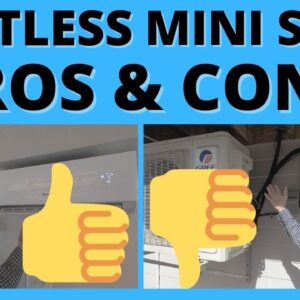The Pros and Cons of Ductless HVAC Systems
With the rise of technological advancements in the HVAC (Heating, Ventilation, and Air Conditioning) industry, the ductless mini-split system has recently surged in popularity. Ideal for both residential and commercial uses, these systems provide efficient and effective climate control solutions. This article explores at length what makes ductless systems appealing and what potential drawbacks consumers may face.
Pros of Ductless Systems
- Makes It Possible to Cool Older Homes
One of the most compelling advantages of ductless systems is their adaptability, particularly for older homes where installing a central air conditioning system would be problematic or even impossible. Central air systems require extensive ductwork, which can be hard to install in older homes with unique architectural characteristics. Ductless units bypass the need for ductwork, making it feasible to air-condition spaces that might otherwise rely on less effective alternatives like window units. Thus, even century-old beach houses or other vintage residences can experience modern comforts without compromising architectural integrity.
- Energy Efficiency
Another significant benefit of ductless systems is their remarkable energy efficiency. Traditional HVAC systems can lose up to 30% of energy through ductwork due to leaks, poor insulation, or simply because air has to travel longer distances. By eliminating the ductwork, ductless systems ensure that more of the cooled or heated air reaches its destination. Moreover, ductless units often come with inverter technology which adjusts the speed of the compressor to meet the cooling demand rather than merely cycling on and off, which boosts energy efficiency further. With reduced utility consumption, homeowners can enjoy lower electricity bills and a more environmentally friendly household.
- Zone Control and Customization
Perhaps one of the most appealing aspects of the ductless system is zone control, allowing you to customize the temperature in different rooms or areas independently. Each room has its unit, which means you can cool a room being used while turning off units in unoccupied spaces to save energy. Zone control offers the flexibility to maintain different temperatures in various parts of your house. Some family members might prefer cooler bedrooms while others like their living spaces warmer; ductless systems accommodate all these personal preferences. This ability to customize temperature settings room-by-room leads to enhanced comfort and potentially significant energy savings.
Cons of Ductless Systems
While ductless systems offer many advantages, it is essential to consider their cons to make an informed decision.
- Complex Refrigerant Lines
One of the apparent drawbacks of ductless systems is the need for multiple refrigerant lines running through your house. Every indoor unit connects to an outdoor unit through these lines, which are often installed before drywall goes up. In an older home or during renovations, this means retrofitting the system can be invasive and complex. Additionally, since refrigerant lines are hidden behind walls, you must be cautious when driving nails or drilling, as you might accidentally puncture a line, leading to costly repairs. Over time, the longevity and condition of these lines will also need monitoring. If they degrade or damage occurs, repairs can be labor-intensive, potentially requiring cuts into drywall to access the lines. Hence, maintenance-backed safeguards should be a key consideration.
- Replacement and Repair Concerns
Another critical issue is the possibility of needing to replace or repair these systems later on. As technology advances, new refrigerants and component standards come into play, potentially rendering old lines incompatible with new units. Replacing an indoor unit might be more complicated than just swapping out the hardware; it may involve updating refrigerant lines or other system components, possibly requiring invasive work. The lifespan and durability of these refrigerant lines are also concerning, as they were installed before the drywall. Questions of whether these lines will remain in good condition a decade later linger, making it essential to take future maintenance and adaptability into account.
- Cost
Contrary to initial consumer perceptions, ductless systems are by no means budget-friendly. The installation is intricate and requires skilled labor, contributing to higher upfront costs. Unlike window air conditioners, whose installation is straightforward, ductless systems involve careful planning, drilling holes for lines, mounting units, and possibly electrical work to handle the power requirements. Both the installation costs and the units themselves can be expensive, sometimes comparable to traditional central air conditioning systems. Those looking at tissue them are directed, therefore, to think more along the lines of an investment rather than a cost-cutting measure.
Conclusion
The rise of ductless HVAC systems showcases the convergence of innovative technology and modern living needs. Their adaptability makes them a viable option for older homes where traditional systems cannot be feasibly installed, and their energy efficiency means that they align strongly with today’s emphasis on sustainability. The ability to implement zone control further positions them as a versatile solution for households with varied temperature preferences.
However, the system is not without its challenges. The complexity and number of refrigerant lines make installation invasive and potentially risky. Future maintenance and repairs can also be more cumbersome and costly, particularly if technological changes render existing lines obsolete. And while the initial cost of installation is steep, considering it an investment in comfort, efficiency, and potential energy savings may help to offset the upfront expenditure.
For homeowners contemplating upgrading or installing a new HVAC system, the benefits of ductless units may very well outweigh the drawbacks. Yet, it remains essential to consult with seasoned professionals for installation and future maintenance to ensure you maximize the system’s advantages while mitigating its cons. Ductless systems embody a blend of modern ingenuity and practical functionality, offering a pathway to enhanced comfort and efficiency in our living spaces.

